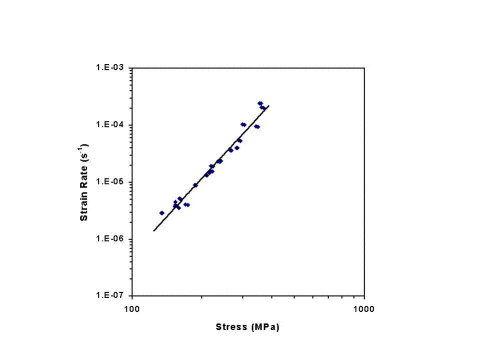

Magnesiowüstite is thought to be the mechanically weakest phase of the major constituents within the Earth's lower mantle. Studies of the deformation behavior of polyphase materials have shown that above a threshold volume fraction it is the grain size and volume fraction of the weak phase that controls the rheology of the material. Although models of the lower mantle bulk composition indicate that magnesiowüstite comprises less than the critical value required to form an interconnected network, its presence as weak isolated grains may reduce the strength of an aggregate dominated by silicate perovskite by providing local accommodation of strain mismatch at grain boundaries. Magnesiowüstite will become the rheologically important phase in areas of small scale compositional layering (i.e., peridotitic composition 30% by volume or dunitic to harzburgitic 50% by volume). Despite the importance of magnesiowüstite and the large stability field which make it a very tractable material to work with, there has been relatively little detailed work performed on its rheological behavior.
We have performed experiments in our new Paterson deformation apparatus on polycrystalline samples of magnesiowüstite. Samples with an MgO:FeO of 80:20 were prepared from Fe2O3 and MgO powders that had been intimately mixed, and annealed at 1673 K for 10 h at controlled oxygen fugacities. The powders were then ground, reannealed to attain chemical homogeneity, reground and then sieved to yield grain sizes of less than 10 microns. The powders were cold-pressed to 200 MPa, and then hot-pressed at 300 MPa and 1200 K for 12 h in an iron jacket. The temperature of this hot-pressing stage was sufficient to cause grain growth and generate an equilibrated microstructure with a grain size of approximately 20 microns. The final density of the samples was approximately 97% of the theoretical density.
Suites of constant stress and stress stepping axial deformation experiments were performed at the following conditions: confining pressure 300 MPa; temperatures from 1000 to 1400 K; axial strain rates of 10-4 to 10-7 s-1. In all cases the oxygen activity was buffered near Fe/FeO by the iron jacket.
The results of the deformation tests are summarized on the log strain rate vs. log stress plot and log strain rate vs 1/temperature plot shown in Figure 3.1-14a,b. A stress exponent of approximately n=5 was determined at 1200 K, indicating dislocation controlled creep and an activation energy of approximately Q=230 kJ/mol. Microstructures reveal grain flattening, indicating that dislocation glide is the main strain accommodating mechanism.
 |
Fig. 3.1-14a: Log strain rate vs. log stress for (Mg,Fe)O deformed during constant stress stepping tests at a temperature of 1200 K. |
 |
3.1-14b: Log strain rate vs. inverse temperature for (Mg,Fe)O deformed during temperature stepping tests at a constant stress of 300 MPa. |

Tel: +49-(0) 921 55 3700 / 3766, Fax: +49-(0) 921 55 3769, E-mail: bayerisches.geoinstitut(at)uni-bayreuth.de
 Previous page
Previous page